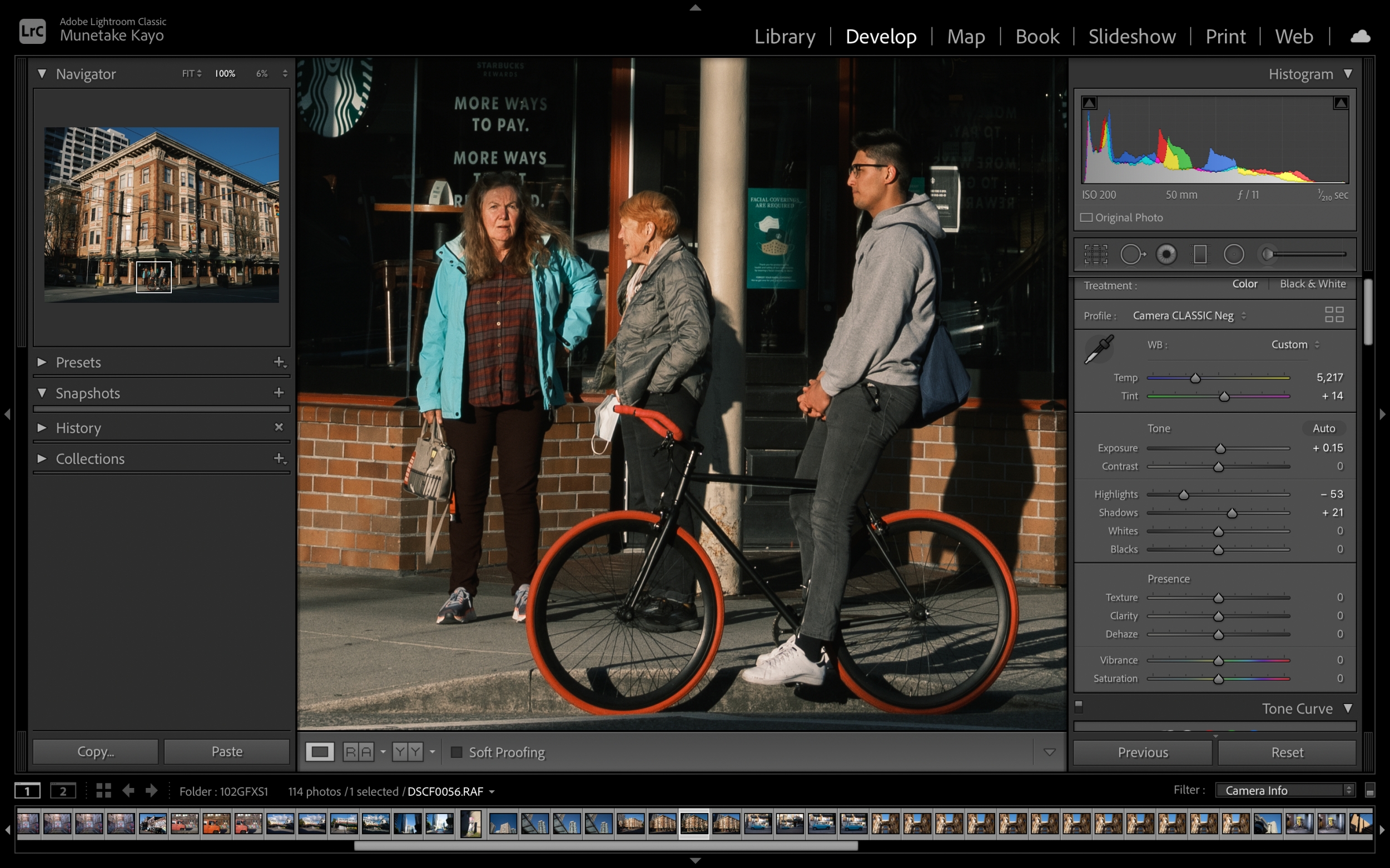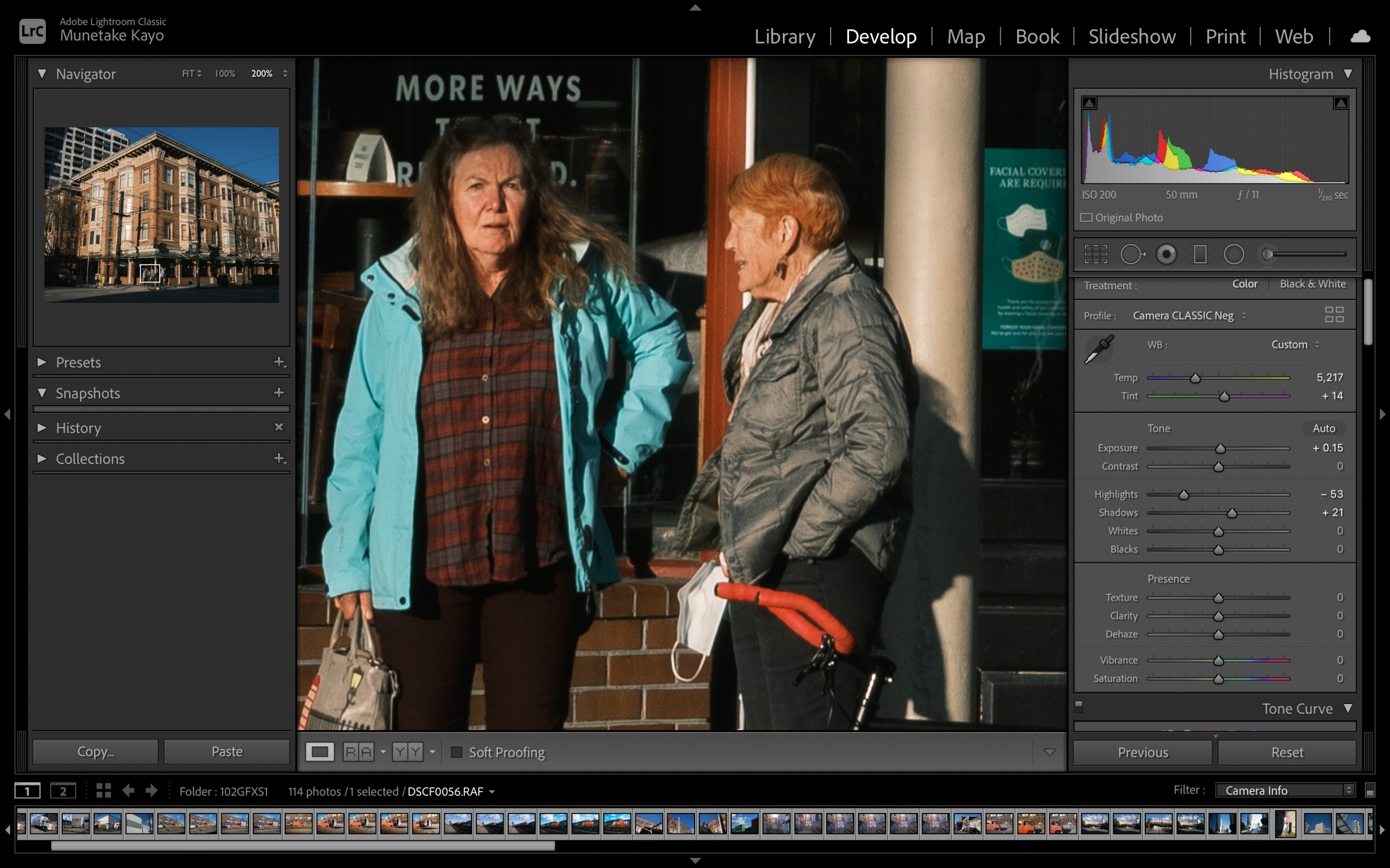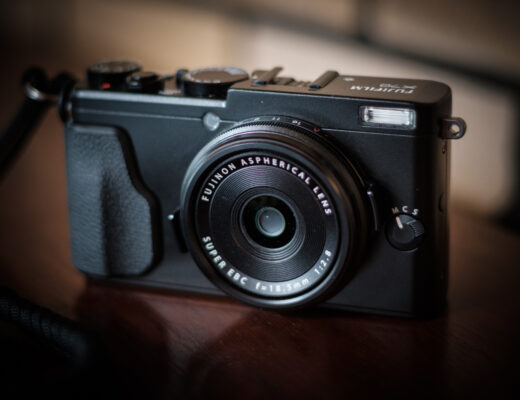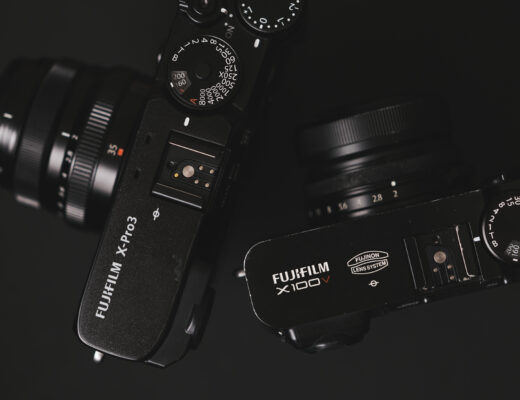If you are a current Fujifilm X Series owner, should you care about the GFX series? Yes, you should. Even if you don’t plan to get into digital medium format photography, we should all pay attention to what Fujifilm is doing with the GFX cameras. Many design and ergonomic decisions made on the GFX cameras often find their way into the X Series cameras. For instance, the GFX 50S was the first Fujifilm camera to offer a touch screen on a pro-level body. The GFX 50R was the first time Fujifilm put an articulating screen on a rangefinder-styled body. It appears Fujifilm engineers are willing to take more risks on their medium format cameras, perhaps because it’s still a young series. The X-Pro, X-T, and X100 cameras have many years and generations of history to consider when making design choices, but not the GFX line-up. I would even argue that the new GFX100S is not really a generation 2 version of the GFX 50S. Notice how the GFX100S name has no space between GFX and 100S, while the GFX 50S does? It’s subtle, but I think Fujifilm is making a low-key distinction between these two as parallel series of cameras.
 Be that as it may, for the sake of this review I will compare the original GFX 50S with the GFX100S, mostly from a design, ergonomics, and functionality perspective. Because the GFX 50S is four years older, the GFX100S clearly has a more capable sensor and processor, allowing for higher resolution images, faster autofocus, improved video features, and new software features (Multi-Exposure Additive, Pixel Shift, etc.). To begin, let’s quickly look at the Pros and Cons of the new GFX100S in comparison to the GFX 50S.
Be that as it may, for the sake of this review I will compare the original GFX 50S with the GFX100S, mostly from a design, ergonomics, and functionality perspective. Because the GFX 50S is four years older, the GFX100S clearly has a more capable sensor and processor, allowing for higher resolution images, faster autofocus, improved video features, and new software features (Multi-Exposure Additive, Pixel Shift, etc.). To begin, let’s quickly look at the Pros and Cons of the new GFX100S in comparison to the GFX 50S.
PROS of the GFX100S
- smaller footprint, specifically thinner along the back in comparison to the GFX 50S
- cheaper at launch ($6000 USD) compared to the GFX 50S ($6500 USD)
- new BSI sensor with on-sensor phase detect technology for improved autofocus
- improved NP-W235 battery system
- latest X Processor IV quad-core processor
- improved autofocus, improved video (4K), overall faster performance
- 6 stops of IBIS (very effective)
- Improved button-dial layout, including a physical Movie-Still switch
- standard eyelet strap lug
- kaizen improvement to firmware and menus (it remembers where you were previously)
CONS of the GFX100S
- removal of ISO dial, shutter speed dial, and D-pad
- no dedicated ISO dial (virtual dial) and replaced with PSAM dial
- less modular (no removable EVF, no battery grip)
- same EVF and LCD resolution as older GFX 50S
- same top shutter speed / flash sync speed as GFX 50S
- similar ISO sensitivity (max ISO 12,800) as GFX 50S
- new 8-way focus lever-joystick can be tricky to navigate in menus
- no included external battery charger
From a functional perspective, the new GFX100S is an awesome image-making machine. Having a usable 100MP sensor with IBIS in such a compact body is a very powerful tool in the hands of a competent photographer. If you are a landscape, portraiture, or product photographer, you’re going to simply love this camera. If you notice, I didn’t list the 100MP sensor as a PRO in the above list, because it’s not. 100MP isn’t inherently ‘better’ than a 50MP sensor, it’s just… more pixels. If you don’t need 100MP, then don’t feel compelled to buy into getting more resolution just for the sake of it. For my style of photography, it’s not necessary. I would rather have improved low-light high ISO performance over higher resolution any day. However, for those who need or want this much resolution, you have it with this camera. If you need even more resolution, Pixel Shift allows up to a 400MP composite image. Amazing.
 The biggest ergonomic change between the older GFX 50S and the new GFX100S is the replacement of the older NP-T125 battery with the new NP-W235 battery from the X-T4. This slimmer battery now fits in the grip section of the new GFX100S, allowing for a much slimmer profile. The GFX 50S and GFX100 both suffered from having to fit the chunky NP-T125 battery somewhere into the body. The GFX100 fit it along the bottom of the non-removable battery grip; while the GFX 50S had it sandwiched between the sensor and rear LCD screen, giving it a hunch-back look from the side. This also forced the engineers to awkwardly place the focus select dial, delete button and play button on the top-shelf above the LCD screen. With this slimmer profile of the GFX100S, it was easy for me to carry the camera around my neck with a strap and not feel the camera digging into my chest or ribs.
The biggest ergonomic change between the older GFX 50S and the new GFX100S is the replacement of the older NP-T125 battery with the new NP-W235 battery from the X-T4. This slimmer battery now fits in the grip section of the new GFX100S, allowing for a much slimmer profile. The GFX 50S and GFX100 both suffered from having to fit the chunky NP-T125 battery somewhere into the body. The GFX100 fit it along the bottom of the non-removable battery grip; while the GFX 50S had it sandwiched between the sensor and rear LCD screen, giving it a hunch-back look from the side. This also forced the engineers to awkwardly place the focus select dial, delete button and play button on the top-shelf above the LCD screen. With this slimmer profile of the GFX100S, it was easy for me to carry the camera around my neck with a strap and not feel the camera digging into my chest or ribs.
 In the hand, both the GFX 50S and GFX100S feel really nice, both with deep grips and properly angled shutter buttons. The leather-like wrap on the new GFX100S is the same as on the GFX100, but different from the more leather-like feel of the older GFX 50S. The new top panel LCD is much larger on the GFX100S, but at the cost of removing the shutter speed dial. Fujifilm also replaced the functional ISO dial on the left and replaced it with a PSAM dial. For those who are new to Fujifilm, this is a familiar way to switch between program, aperture priority, shutter priority, and full manual control. For seasoned Fujifilm shooters, this dial can be seen as a waste of space. Put the lens in A mode and use the shutter dial for shutter speed priority. Put the shutter speed dial in A and use the aperture ring for aperture priority. Put both the lens and shutter speed dial in A mode and you get program mode. Is it worth losing both the shutter speed dial and ISO dial so we can have a PSAM and a virtual shutter speed and ISO dial? For me, the answer is no. I don’t find the virtual dials on the LCD screen quicker or intuitive in comparison to having a physical dial.
In the hand, both the GFX 50S and GFX100S feel really nice, both with deep grips and properly angled shutter buttons. The leather-like wrap on the new GFX100S is the same as on the GFX100, but different from the more leather-like feel of the older GFX 50S. The new top panel LCD is much larger on the GFX100S, but at the cost of removing the shutter speed dial. Fujifilm also replaced the functional ISO dial on the left and replaced it with a PSAM dial. For those who are new to Fujifilm, this is a familiar way to switch between program, aperture priority, shutter priority, and full manual control. For seasoned Fujifilm shooters, this dial can be seen as a waste of space. Put the lens in A mode and use the shutter dial for shutter speed priority. Put the shutter speed dial in A and use the aperture ring for aperture priority. Put both the lens and shutter speed dial in A mode and you get program mode. Is it worth losing both the shutter speed dial and ISO dial so we can have a PSAM and a virtual shutter speed and ISO dial? For me, the answer is no. I don’t find the virtual dials on the LCD screen quicker or intuitive in comparison to having a physical dial.

 The removal of the D-pad on the GFX100S is also a CON since there’s enough space to have included one. The D-pad isn’t just a navigational tool that can be replaced by the focus lever aka joystick. the D-pad also gives you 4 extra custom function buttons and the Menu-OK button. I also prefer to have a physical Drive dial versus a Drive button that has to be navigated via the menu screen. Even with the camera turned off, a physical Drive dial will show you what mode you’re in. I also feel that the Drive and Delete button could have been merged into a single button, freeing up an extra button to be customized. However, like any new design, you get used to it quickly enough and find workarounds. The best top panel design of any Fujifilm camera is the X-H1, with two main dials, two sub-dials, a top panel LCD screen, and two large and rounded AE-L and AF-L buttons right at your thumb. The second best design is the X-T4.
The removal of the D-pad on the GFX100S is also a CON since there’s enough space to have included one. The D-pad isn’t just a navigational tool that can be replaced by the focus lever aka joystick. the D-pad also gives you 4 extra custom function buttons and the Menu-OK button. I also prefer to have a physical Drive dial versus a Drive button that has to be navigated via the menu screen. Even with the camera turned off, a physical Drive dial will show you what mode you’re in. I also feel that the Drive and Delete button could have been merged into a single button, freeing up an extra button to be customized. However, like any new design, you get used to it quickly enough and find workarounds. The best top panel design of any Fujifilm camera is the X-H1, with two main dials, two sub-dials, a top panel LCD screen, and two large and rounded AE-L and AF-L buttons right at your thumb. The second best design is the X-T4.
This leads me back to the first paragraph of this article, as well as the title. Is the new GFX100S the future design language of upcoming Fujifilm cameras? Like the other GFX cameras, I hope this is Fujifilm allowing their engineers to experiment a bit, and not set in stone any design direction. The removal of the D-pad has been happening on too many cameras recently, and I’m worried that the upcoming X-H2 will have it removed as well. I also hope Fujifilm can balance the use of the top panel LCD with physical dials. I want the ISO dial, shutter speed dial, and sub-dials to continue in future Fujifilm cameras; but also incorporate the use of a sub-dial when useful. As for the new joystick design, I still need to get used to it. I like the bigger size, but it’s clumsy when in menu mode. Perhaps Fujifilm can make it into a 4-way lever when in menus and 8 way when using it as a focus lever.
The addition of IBIS on the new GFX100S is such an awesome feature, that it alone is worth the current $500 price difference between the older GFX 50S. However, spec-for-spec, the price difference between these two cameras should be at least $1500, if not more. For $500 more, you get the new 100MP BSI phase-detect sensor, IBIS, a quad-core processor, an improved battery system, Bluetooth, the latest firmware with new film simulations, 4K video performance, and a dozen other new features. Yes, the GFX100S basically has the same mechanical focal plane shutter with no improvement in top shutter or flash sync speed, the same EVF and LCD with the same resolution, and less modular than the GFX 50S. However, as previously mentioned, I don’t think the GFX100S (no space) is a direct replacement for the GFX 50S. The GFX100S is its own series with its own future direction. Moreover, Fujifilm has always taken into consideration the needs and feedback from its user base and is willing to make changes when necessary. Hopefully, the modular capabilities of the GFX 50S will continue, if and when Fujifilm decides to make a version II in the near future.
I have been testing the new GFX100S for the past couple of weeks and so far I’m loving the camera. The number one feature for me is IBIS, then it’s the phase-detect autofocus, and finally the overall faster operation due to the new sensor and the X Processor IV combination. The kaizen improvements to the menu system and button layout are also nice, including the dedicated Video-Still switch, which also displays a dedicated menu layout. The menu even remembers the last menu item you were in last, so there’s no need to continually re-navigate back to where you were last. I have more testing to do, including the new GF80mm f/1.7 lens. For now, I am happy to see Fujifilm amalgamating various technologies from different cameras and creating this hybrid GFX camera that is smaller, lighter, cheaper, and yet more powerful than before. I look forward to future improvements to both GFX and X Series cameras, but please don’t phase out the D-pad. Thanks for reading and happy shooting!




























